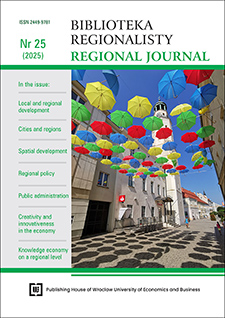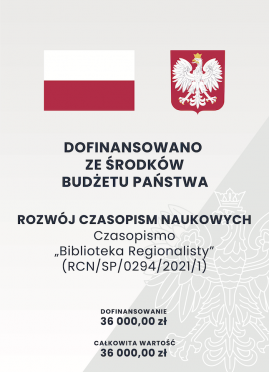Shaping Complete Housing Estates in Wrocław as an Implementation of the Idea of a Short-Distance City; Taking into Account the Principles of Universal Design and Accessibility
DOI:
https://doi.org/10.15611/br.2025.1.13Keywords:
city of short distances, Wrocław, complete housing estate, universal design, accessibilityAbstract
Aim: Climate change requires cities to act quickly and flexibly. In these realities, the concept of short-distance cities creates the basis for responding to the challenges cities face. The aim of the article is to indicate a possible path to implementing the idea of a short-distance city in a large city that creates conditions of accessibility and in this direction takes into account the principles of universal design.
Methodology: The research methodology is based on a critical review of literature and strategic and planning documents; case study; expert method. The study focused on the example of Wrocław, where a project to create complete housing estates was used.
Implications and recommendations: The basic finding resulting from the study is the need to develop the city of short distances in such a way that it is publicly accessible, inclusive and multifunctional. This is how the project of complete housing estates is being implemented in Wrocław, which is intended to create perfect spaces that meet the needs of all residents. It is recommended that the principles of universal design and striving to make space accessible to those who want to use it should become the basis for design activities.
Originality/value: The description of the construction of a city of short distances and its values has already been relatively well presented in the literature; the originality of the study refers to the connection of the construction of complete housing estates with this idea of the city, along with taking into account the principles of universal design and accessibility.
Downloads
References
Beim, M. (2021, 25 grudnia). Mobilność. Koncepcja miasta piętnastominutowego. Transport Publiczny. Pobrano 30.01.2025 z https://www.transport-publiczny.pl/wiadomosci/koncepcja-miasta-pietnastominutowego--71610.html
Bryla.pl. (2023, 7 lipca). Jak zaprojektować samowystarczalne miasto? Pobrano 30 stycznia 2025 z https://www.bryla.pl/jak-zaprojektowac-samowystarczalne-miasto
Budowlane ABC. (b.d.). Projektowanie uniwersalne – objaśnienie koncepcji. Pobrano 30 stycznia 2025 z https://budowlaneabc.gov.pl/standardy-projektowania-budynkow-dla-osob-niepelnosprawnych/wprowadzenie/projektowanie-uniwersalne-objasnienie-koncepcji/
F5. (2021, 23 grudnia). Sztokholm chce być miastem 1-minutowym. Pobrano 30 stycznia 2025 z https://www.f5.pl/futopia/sztokholm-chce-byc-miastem-1-minutowym
Hołuj, A. i Lityński, P. (2015). Urban spraw – uwarunkowania oraz propozycja zmian w Polsce. Studia Komitetu Przestrzennego Zagospodarowania Kraju, (161), 91-99.
Jednostka urbanistyczna A11 w Studium Wrocławia. (2019). Osiedle kompletne. Śródmieście Południowe. Wytyczne prze-strzenne na rzecz osiedla kompletnego. Biuro Rozwoju Wrocławia.
Konwencja o prawach osób niepełnosprawnych z dnia 13 grudnia 2006 r. (Dz. U. z 2012 r., poz. 1169)
LAB60+. (2016). Wytyczne w zakresie projektowania uniwersalnego mając na uwadze potrzeby osób niepełnosprawnych. Fundacja Laboratorium 60+.
Marchewka, C. (2020, 13 sierpnia). Osiedla kompletne we Wrocławiu. Miasto konsultuje, kiedy można się spodziewać efektów? Gazeta Wrocławska. Pobrano 30 stycznia 2025 z https://gazetawroclawska.pl/osiedla-kompletne-we-wroclawiu-miasto-konsultuje-kiedy-mozna-sie-spodziewac-efektow/ar/c1-15125225
Miasto2077 / Green is Good. (2021, 10 marca). Sztokholm chce być miastem 1-minutowym. Pobrano 30 stycznia 2025 z https://www.miasto2077.pl/sztokholm-chce-byc-miastem-1-minutowym/
Michalska-Żyła, A. (2024). 15-minutowe zielone miasto kompaktowe – koneksje, wyzwania i perspektywy. Nowa Polityka Wschodnia, 41(2), 28-42.
Moreno, C., Allam, Z., Chabaud, D., Gall, C. i Pratlong, F. (2021). Introducing the “15-Minute City”: Sustainability, Resilience and Place Identity in Future Post-Pandemic Cities. Smart Cities, 4(1). https://doi.org/10.3390/smartcities4010006
Neuman, M. (2005). The Compact City Fallacy. Journal of Planning Education and Research, 25(1),11-26.
Noworól, A., Kopyciński, P., Hałat, P., Salamon, J., Baziak, J., Sypek, W. i Wirchniańska, M. (2021). Czy Kraków może stać się „miastem 15-minutowym”? Raport autorski. Wydawnictwo Małopolskiej Szkoły Administracji Publicznej Uniwersytetu Ekonomicznego w Krakowie.
Pasek, A. (2019). Potrzeby społeczne związane z rozwojem społeczeństwa. Zeszyty Naukowe Zbliżenia Cywilizacyjne, 15(1), 56-81. http://dx.doi.org/10.21784/ZC.2019.004
Uchwała Nr XX/419/16 Rady Miejskiej Wrocławia z dnia 21 stycznia 2016 r. zmieniająca uchwałę nr XX/110/91 Rady Miejskiej Wrocławia w sprawie podziału Wrocławia na osiedla. Pobrano 12 stycznia 2024 z https://baw.um.wroc.pl/UrzadMiastaWroclawia/document/26598/
Urząd Statystyczny we Wrocławiu. (2023). Rocznik Statystyczny Wrocławia 2023, s. 135.
Downloads
Published
Issue
Section
License
Copyright (c) 2025 Dorota Rynio

This work is licensed under a Creative Commons Attribution-ShareAlike 4.0 International License.
Accepted 2025-03-17
Published 2025-06-27







